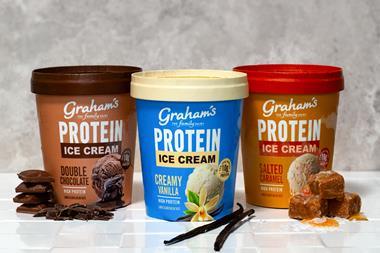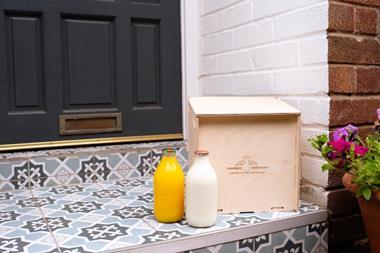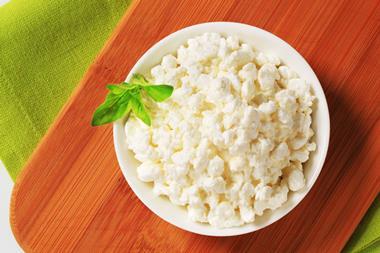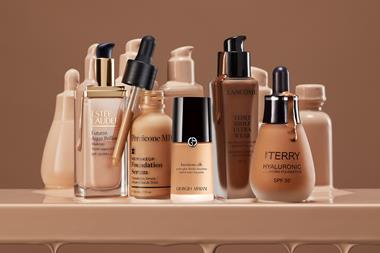The growth of dairy spreads is churning up the butter market and creating openings for retailers. Peter Crosskey separates the issues
After years of self-denial, consumers are beginning to realise that a little of what you fancy does you good at least, when they shop the yellow fats fixture.
According to latest figures from Taylor Nelson Sofres, total consumption of butter and dairy spreads grew by more than 8% in the 12 months to April 30, while sales of vegetable based low fat alternatives remained static.
"Spreadables means that butter is coming back," says Simon Tuckey, New Zealand Milk (UK) md, pointing to a long term growth in butter and spreadable brands over the last three years. So convinced are the New Zealanders that this is a market worth taking that they will be investing £10m in the Anchor brand this year in an attempt to "shake up the yellow fats fixture" no doubt putting further pressure on low fat brands where only Olivio is bucking a downward trend.
For Simon Eyles, unit manager for Lurpak brand owner Arla Foods, spreadables have been the salvation for the dairy fats market.
"They are especially popular with shoppers who demand the convenience of a spreadable and yet still want the taste of butter," says Eyles, who has seen them help take the total value of the Lurpak brand to over £100m. This year, the company will be spending £9m on the Lurpak marketing campaign a third up on last year including two new TV commercials starring Douglas, the butterfat figure who has been blowing his trombone for the brand since 1986.
St Ivel, meanwhile, which claims a 20.3% value share of a £487.5m margarine and spreads market, relaunched its Gold brand last September and is about to begin a £5m TV campaign, featuring a floating cow being winched down by a farmer after milking. Beginning on July 3, it's the second burst of three ads planned for this year.
And there's more activity on the horizon. Last month's launch of a 250g tub for Utterly Butterly saw the addition of a freephone number on all its packs. This is being followed with a £3m TV campaign this summer, in addition to the brand's multi-million pound sponsorship of the Utterly Butterly Barnstormers aerial demonstration team.
This year the sponsorship has been used to advertise a vacancy for a daredevil wingwalker and to offer family tickets to airshows where the team will fly their three branded biplanes.
St Ivel's Golden Churn is to be relaunched at the end of July with a new pack shape, more contemporary label, and a reformulated recipe. A £1.5m TV campaign starts in September to flag its new look.
Wheelbarrow, the unsalted Dutch butter brand, is also rolling out a consumer campaign for packet butter for the first time with pr concentrated on women's magazines, leading regional newspapers, and sampling.
With an annual advertising spend across the fixture hovering around the £40m mark, only confectionery invests more on promotion. But the yellow fats message is more complex.
"One of the problems in the market is that people think they are buying spreadable butter, but some of these are butter with oil mixed in, so they don't deliver like butter," says Waitrose central dairy buyer David Jones. "I think that they're seen as ersatz. So it's back to authentic traditional products, and that's what we do."
Waitrose has been selling a soft tub variant of President butter from French dairy giant Lactalis. The variant is about to be repackaged, but Lactalis UK md Andy Smith is already pleased with the results.
"Our business with Waitrose has gone up by over a third, but without cannibalising other butters," he says. Overall UK sales have risen 20% year on year.
Marks of authenticity, such as AOC (Appélation d'Origine Controlée) can be a strong selling point for butters, and Jones believes the fixture can only gain from such diversity.
"Butter can be a wall of yellow," he says. "You've got to look at what the customer wants. We've got 12ft fixtures 4ft of butter and 8ft of dairy spreads. We have really tried to differentiate ourselves there's butter in baskets or clay pots, Isigny AOC butter, or Brittany butter with sea salt."
Despite the fact that aggressive retail pricing has brought the rsp for own label and tertiary brand packs below 50p/250g, Waitrose's experience is that consumers who choose spreadables during the week view traditional packet butter as a treat for the weekends and the potential therefore exists to trade up.
Major national brands are obviously of the same opinion. They have retained their retail prices at two to three times that of the cheapest butter on the fixture.
"If they want butter and you can add value with a good choice of premium lines, then £1.40 is not so much more than 89p for a treat," says Jones.
{{FOCUS SPECIALS }}
Close menu
- Home
- Retail & Wholesale
-
Products & Suppliers
- Back to parent navigation item
- Products & Suppliers
-
Product Categories:
- Back to parent navigation item
- Product Categories:
- Alcoholic drinks
- Bakery
- Cereals & breakfast
- Cheese
- Chicken & poultry
- Chocolate
- Confectionery
- Crisps, nuts & snacks
- Dairy
- Fish
- Fresh produce
- Frozen
- Household
- Meat
- Own Label
- Sauces & condiments
- Seasonal
- Soft drinks
- Vaping
- Vegan & plant-based
- World foods
- Suppliers
- People
- Reports & Data
-
Topics A-Z
- Back to parent navigation item
- Topics A-Z
-
Popular topics:
- Back to parent navigation item
- Popular topics:
- Cost of living crisis
- Crime
- Deposit Return Schemes
- Finance
- Government & Regulation
- Health
- Inflation
- Loyalty
- Marketing
- Mergers & Acquisitions
- New Product Development
- Sourcing
- Supply chain
- Sustainability & environment
- Technology
- Ultra Processed Foods
- Vaping
- A-Z all topics
- Content by type:
- Events
- Ask iA (beta)
- Subscribe now
Sign in to comment on this article
Not logged in before? Register for FREE guest access today.
You will be able to:
- Read more stories
- Receive daily newsletters
- Comment on stories
Advert



















No comments yet